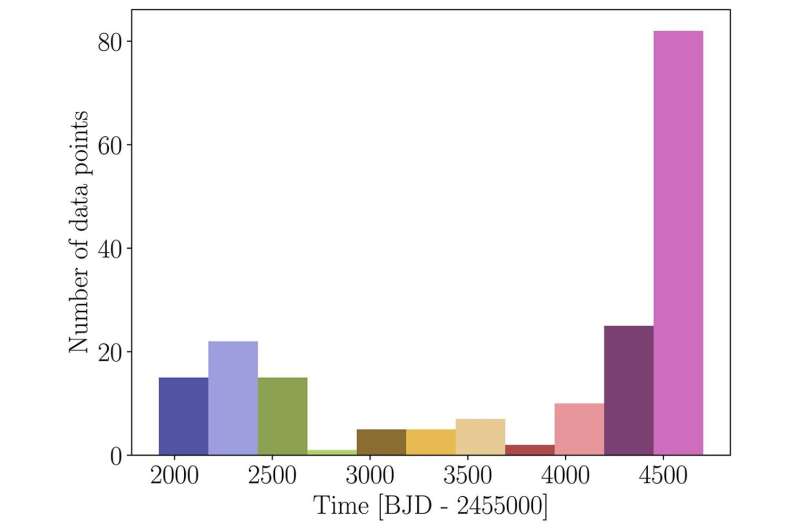This article has been reviewed according to Science X's editorial process and policies. Editors have highlighted the following attributes while ensuring the content's credibility:
fact-checked
peer-reviewed publication
trusted source
proofread
Astronomers find three potential super-Earths around nearby star

Astronomers have discovered three potential "super-Earth" exoplanets orbiting a relatively nearby orange dwarf star. This groundbreaking find was made by an international team of researchers led by Dr. Shweta Dalal from the University of Exeter.
The exoplanets are orbiting Star HD 48498, located approximately 55 light-years from Earth. These planets revolve around their host star in 7, 38, and 151 Earth days, respectively. Notably, the outermost exoplanet candidate resides in the habitable zone of its host star, where conditions could allow liquid water to exist without boiling or freezing. This region, often referred to as the Goldilocks zone, is considered ideal for potentially supporting life.
The researchers highlight the importance of this discovery, noting that this orange star is somewhat similar to our sun and represents the closest planetary system to host a Super-Earth in the habitable zone around a sun-like star.
The study detailing these findings was published in the journal MNRAS on June 24, 2024.

Dr. Dalal said, "The discovery of this Super-Earth in the habitable zone around an orange star is an exciting step forward in our quest to find habitable planets around solar-type stars."
These potential Super-Earths, planets with a mass greater than Earth but significantly less than the solar system's ice giants Uranus and Neptune, were identified through the HARPS-N Rocky Planet Search program. Over a decade, the team collected nearly 190 high-precision radial velocity measurements using the HARPS-N spectrograph.
Radial velocity measurements, which track the star's subtle movements caused by orbiting planets, are crucial in such discoveries. By analyzing the spectrum of light from the star, researchers can determine whether it is moving towards us (blueshift) or away from us (redshift). To ensure the accuracy of their findings, the team employed various methodologies and comparative analyses.
The research revealed three planetary candidates with minimum masses ranging from 5- to 11-times that of Earth. The team suggests that the proximity of the star, combined with the outermost planet's favorable orbit, makes this system a promising target for future high-contrast direct imaging and high-resolution spectroscopic studies.
Dr. Dalal added, "This discovery highlights the importance of long-term monitoring and advanced techniques in uncovering the secrets of distant star systems. We are eager to continue our observations and look for additional planets in the system."
This discovery opens new doors for understanding planetary systems and the potential for life beyond our solar system.
More information: S Dalal et al, Trio of super-Earth candidates orbiting K-dwarf HD 48948: a new habitable zone candidate, Monthly Notices of the Royal Astronomical Society (2024). DOI: 10.1093/mnras/stae1367
Journal information: Monthly Notices of the Royal Astronomical Society
Provided by University of Exeter




















